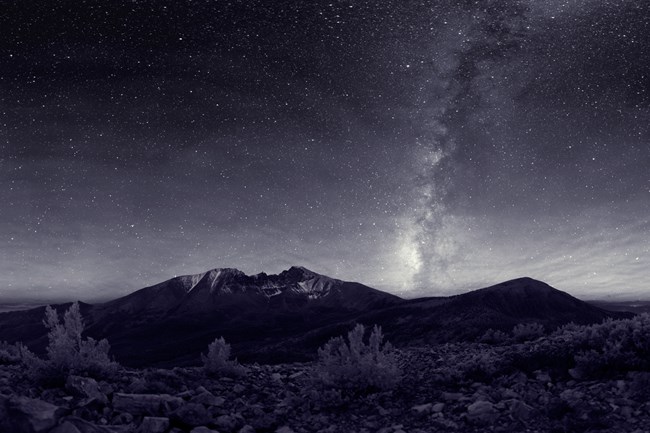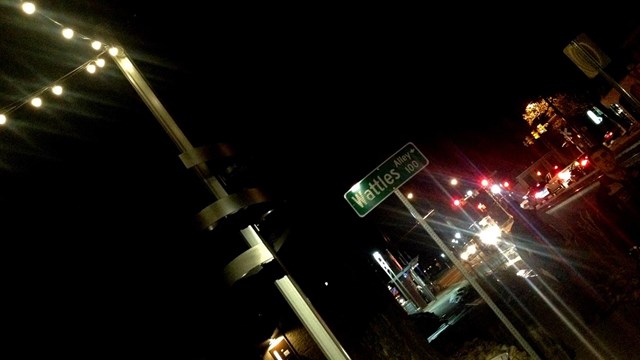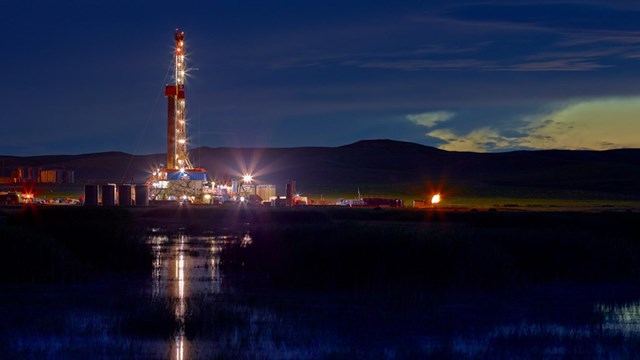
NPS / Dan Duriscoe
The night sky can be one of the most awe-inspiring views we will ever experience. Many people seek protected lands, such as national parks and wilderness areas, to experience starry skies and dark nights. But the night sky and natural darkness are easily damaged and in many places are becoming lost in the glow of artificial lights. At the turn of the century it was estimated that two-thirds of the country's population live where they cannot see the Milky Way (Cinzano, 2001).
The protection of night skies has only recently been recognized as an important cultural and natural resource by the National Park Service and the nation. And as starry skies have become more rare, park visitor interest in stargazing has increased sharply with corresponding economic benefits.
Maintaining the dark night sky above many national park units is a high priority for the National Park Service, and we actively seek partnerships to restore this heritage. The NPS strives to preserve dark sky viewsheds for the enjoyment of park visitors, and the well-being of wildlife and habitat. Many visitors to national parks report "never seeing night skies this remarkable" or had "forgotten what the Milky Way looked like." Increasingly visitors are seeking out these experiences, and the NPS is proud to point a telescope skyward for them or guide them on a nighttime walk.
A critical step in the management of natural lightscapes is to measure and inventory the night sky condition. To address the measurement of this resource, the NPS Night Skies Team was formed to develop a system to measure and ultimately monitor changes to night sky brightness. Since 2001 the NPS has systematically inventoried night sky quality in approximately 100 parks. The data show that nearly every park measured exhibits some degree of light pollution.
A growing pool of knowledge regarding ecological relationships with light, and the understanding of the impact light pollution has on human perception and experiences, combined with growing night sky data, will help the NPS to manage this resource for the benefit of parks and the people who visit them.
An essential management action is to work with neighboring communities to ensure that the protection of natural lightscapes is integrated into park and community planning. Basic principles such as using existing zoning to set appropriate outdoor lighting usage, following best management practices, and tracking progress can protect and even restore natural lightscapes.
The NPS recognizes the importance of natural lightscapes and supports research and monitoring to protect this vanishing resource. The NPS will preserve, to the greatest extent possible, the natural lightscapes of parks, which are natural resources and values that exist in the absence of human-caused light. To prevent the loss of dark conditions and of natural night skies, the NPS will seek the cooperation of park visitors, neighbors, and local government agencies to prevent or minimize the intrusion of artificial light into the night scene of the ecosystems of park units. The NPS will not use artificial lighting in areas where the presence of the artificial lighting will disrupt dark-dependent natural biological resource components of a park, such as sea turtle nesting locations.
Light pollution is a relatively easy environmental problem to resolve. Solutions are immediate, effective, and often save money. Protecting night skies for ourselves and future generations only takes a bit of knowledge and effort in choosing night sky friendly outdoor lighting.
The protection of night skies has only recently been recognized as an important cultural and natural resource by the National Park Service and the nation. And as starry skies have become more rare, park visitor interest in stargazing has increased sharply with corresponding economic benefits.
Maintaining the dark night sky above many national park units is a high priority for the National Park Service, and we actively seek partnerships to restore this heritage. The NPS strives to preserve dark sky viewsheds for the enjoyment of park visitors, and the well-being of wildlife and habitat. Many visitors to national parks report "never seeing night skies this remarkable" or had "forgotten what the Milky Way looked like." Increasingly visitors are seeking out these experiences, and the NPS is proud to point a telescope skyward for them or guide them on a nighttime walk.
A critical step in the management of natural lightscapes is to measure and inventory the night sky condition. To address the measurement of this resource, the NPS Night Skies Team was formed to develop a system to measure and ultimately monitor changes to night sky brightness. Since 2001 the NPS has systematically inventoried night sky quality in approximately 100 parks. The data show that nearly every park measured exhibits some degree of light pollution.
A growing pool of knowledge regarding ecological relationships with light, and the understanding of the impact light pollution has on human perception and experiences, combined with growing night sky data, will help the NPS to manage this resource for the benefit of parks and the people who visit them.
An essential management action is to work with neighboring communities to ensure that the protection of natural lightscapes is integrated into park and community planning. Basic principles such as using existing zoning to set appropriate outdoor lighting usage, following best management practices, and tracking progress can protect and even restore natural lightscapes.
The NPS recognizes the importance of natural lightscapes and supports research and monitoring to protect this vanishing resource. The NPS will preserve, to the greatest extent possible, the natural lightscapes of parks, which are natural resources and values that exist in the absence of human-caused light. To prevent the loss of dark conditions and of natural night skies, the NPS will seek the cooperation of park visitors, neighbors, and local government agencies to prevent or minimize the intrusion of artificial light into the night scene of the ecosystems of park units. The NPS will not use artificial lighting in areas where the presence of the artificial lighting will disrupt dark-dependent natural biological resource components of a park, such as sea turtle nesting locations.
Light pollution is a relatively easy environmental problem to resolve. Solutions are immediate, effective, and often save money. Protecting night skies for ourselves and future generations only takes a bit of knowledge and effort in choosing night sky friendly outdoor lighting.
References
Cinzano P., Falchi F. Elvidge C. 2001. The First World Atlas of the Artificial Night Sky Brightness, Monthly Notices of the Royal Astronomical Society, 328, 689-707. [646 KB PDF]

Best Practices
National parks, cities large and small, and individuals are taking steps toward improving outdoor lighting and protecting night skies.

Measuring Lightscapes
Resource inventories identify existing night sky quality and the cause of the conditions.
Last updated: April 4, 2024
